Does a Cigarette filter do anything?
 Nov 17, 2014 • 11:03 PM UTC
Nov 17, 2014 • 11:03 PM UTC Unknown Location
Unknown Location 140x Magnification
140x Magnification Unknown
Unknown
Manu Prakash
I am a faculty at Stanford and run the Prakash Lab at Department of Bioengineering at Stanford University. Foldscope community is at the heart of our Frugal Science movement - and I can not tell you how proud I am of this community and grassroots movement. Find our work here: http://prakashlab.stanford.edu
266posts
1192comments
42locations
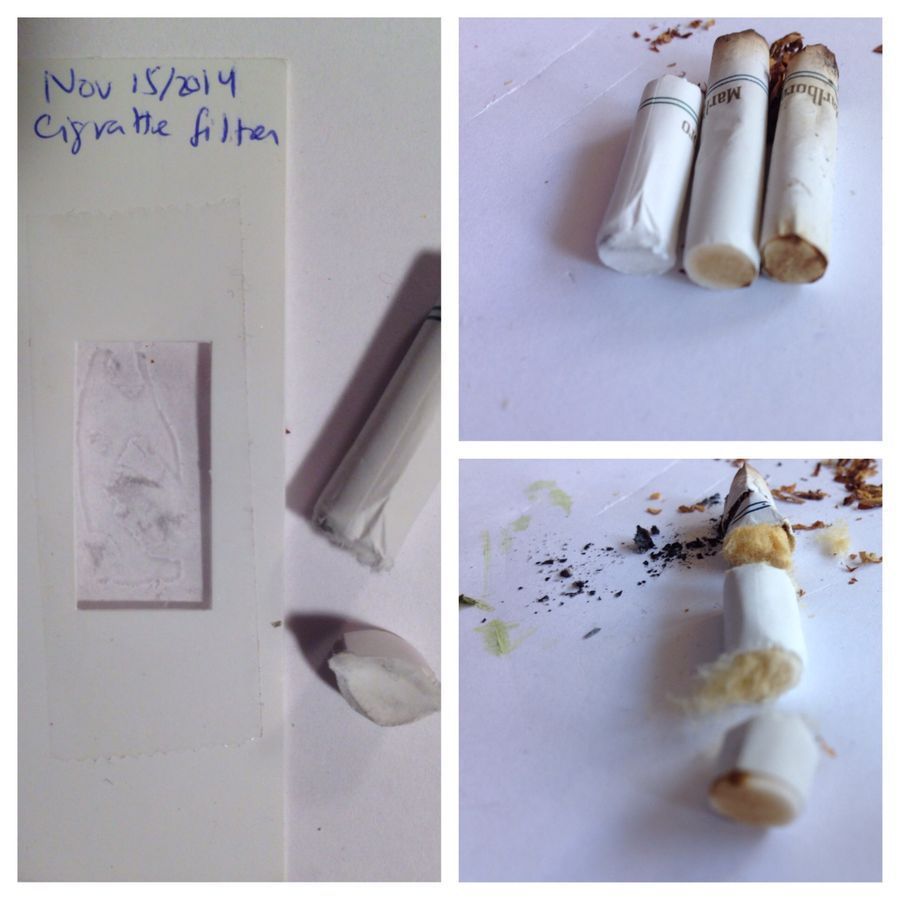
Summary: I wanted to see what cigarette filters look like, and could I actually visualize the pore size to determine if they are capable of filtering anything.
I often walk around looking at all the cigratte butts littering the streets. It is an object that is everywhere – and shows up as non-degradable waste around the world. I also know I’ll effects of smoking and I wanted to see for myself if the label “filter” even makes sense (filter in scientific terms implies it takes out harmful objects uptil a known size. My thought was that maybe it removes some kind of carbon particles that I should be able to visualize on my Foldscope. Sounds like a great project..
Method: I started by walking around my street block and collecting a few cigarette butts. I chose one that was unused and several used. This was I have a control to compare against.
1. With a simple kitchen knife, I opened the cigarette butt and cut it horizontally into multiple pieces. (*i was immediately surprised to notice that the filter was colored in a “brown” tar like color – when compared to unused butt which was “white”. More surprisingly, I also noticed that the coloring was non-uniform across the length of the butt. I still do not understand why – see pictures below).
2. I took small fibers out of the cuts and placed them in a known location on my paper/tape slide. I noted in my diary which selection belonged to which cut section.
3. I started using my Foldscope in low mag setting (140X), with LED light module and condenser lens. I have also the magnetic coupler assembled – because what I saw, I wanted to capture in photos as well.
4. I took pictures by aligning the two magnetic couplers; on my iPhone5 (although I could have used any phone). I often use digital zoom as well to make sure my images are in focus.
5. To take pictures, I put the iPhone on the edge of the table with Foldscope hanging off the table and in my both hands. I focus with my hands and often ask a friend to snatch a picture (more details videos of this will be posted on “help videos” links).
Results : Here are a few images I took. Clearly the “filter” is very very porous – so it is definitely not capable of filtering out any small scale carbon spot. Although it is highly entangled – the fibers themselves are fairly big. I would estimate maybe 100 microns wide fibers that are very long.
I often walk around looking at all the cigratte butts littering the streets. It is an object that is everywhere – and shows up as non-degradable waste around the world. I also know I’ll effects of smoking and I wanted to see for myself if the label “filter” even makes sense (filter in scientific terms implies it takes out harmful objects uptil a known size. My thought was that maybe it removes some kind of carbon particles that I should be able to visualize on my Foldscope. Sounds like a great project..
Method: I started by walking around my street block and collecting a few cigarette butts. I chose one that was unused and several used. This was I have a control to compare against.
1. With a simple kitchen knife, I opened the cigarette butt and cut it horizontally into multiple pieces. (*i was immediately surprised to notice that the filter was colored in a “brown” tar like color – when compared to unused butt which was “white”. More surprisingly, I also noticed that the coloring was non-uniform across the length of the butt. I still do not understand why – see pictures below).
2. I took small fibers out of the cuts and placed them in a known location on my paper/tape slide. I noted in my diary which selection belonged to which cut section.
3. I started using my Foldscope in low mag setting (140X), with LED light module and condenser lens. I have also the magnetic coupler assembled – because what I saw, I wanted to capture in photos as well.
4. I took pictures by aligning the two magnetic couplers; on my iPhone5 (although I could have used any phone). I often use digital zoom as well to make sure my images are in focus.
5. To take pictures, I put the iPhone on the edge of the table with Foldscope hanging off the table and in my both hands. I focus with my hands and often ask a friend to snatch a picture (more details videos of this will be posted on “help videos” links).
Results : Here are a few images I took. Clearly the “filter” is very very porous – so it is definitely not capable of filtering out any small scale carbon spot. Although it is highly entangled – the fibers themselves are fairly big. I would estimate maybe 100 microns wide fibers that are very long.

Slide preparation with used cigarettes found on the street.
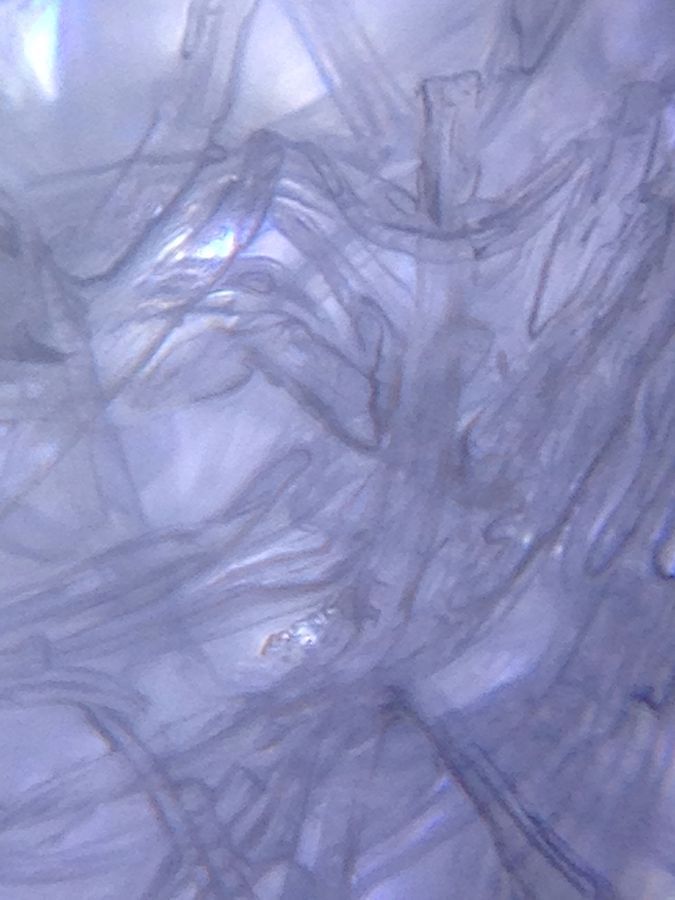
140X Foldscope, maximum digital zoom on iphone5 – clean cigarette filter (unused). Notice the white color.
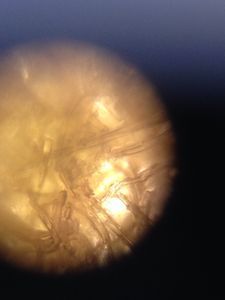
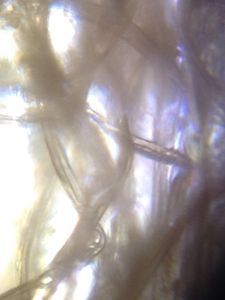
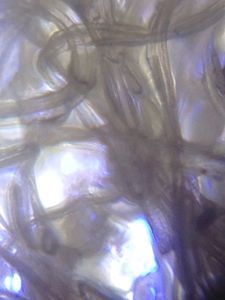
Digital zoom and low magnification image of the used filters. No large carbon particles are seen attached to the filters. The fibers seem to be colored brown.
Conclusions and next steps : I am quiet surprised by the fact that no visible filtered particles seem to be caught in the fibers. Secondly, the fibers themselves are fairly large in size – and thus it would seem they would be incapable of “filtering” any fine scale particle.
Next, I intend to compare these results with more number of cigarette butts from a variety of types. I am also thinking of comparing this to other kind of filters such as hepA or common house hold filters to compare pore size.
Conclusions and next steps : I am quiet surprised by the fact that no visible filtered particles seem to be caught in the fibers. Secondly, the fibers themselves are fairly large in size – and thus it would seem they would be incapable of “filtering” any fine scale particle.
Next, I intend to compare these results with more number of cigarette butts from a variety of types. I am also thinking of comparing this to other kind of filters such as hepA or common house hold filters to compare pore size.
Sign in to commentNobody has commented yet... Share your thoughts with the author and start the discussion!

 0 Applause
0 Applause 0 Comments
0 Comments
















